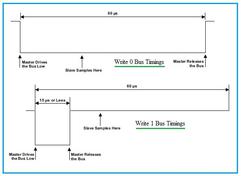
1-Wire Communication Protocol: Single Wire Interface Overview
Explore the 1-Wire protocol, developed by Dallas Semiconductor, which uses a single wire for data transmission, making it cost-effective for diverse applications.
Showing 25 posts (Page 1 of 14)
Advertisement

Explore the 1-Wire protocol, developed by Dallas Semiconductor, which uses a single wire for data transmission, making it cost-effective for diverse applications.

Explore the 2G GSM call flow, detailing network entry procedures, authentication, and call setup between mobile devices and base stations. Includes a call flow diagram.

Explore 2G GSM network interfaces: Um, A, Abis, and Asub. Learn how these interfaces connect key network elements like BTS, BSC, and MSC for seamless communication.

Explore 2G GSM security mechanisms, including authentication, key agreement, message flow, and ciphering algorithms like A5/1, A5/2, and A5/3, ensuring secure mobile communications.

Explore 3D bioprinting, a technology using bio-printers to create body parts or organs. Learn about the process, materials, and challenges in integrating bioprinted organs with the human body.

Explore the security mechanisms in UMTS (3G) networks, focusing on network access, authentication, and key differences from GSM security.

Explore the 3G UMTS protocol stack, covering layers like Physical, Data Link (MAC, RLC, PDCP), and Network (RRC, NAS). Learn about functions, components, and how they ensure reliable communication.

Explore the 4G LTE network architecture, including eNodeB, MME, SGW, PGW, and key interfaces, for efficient mobile communication and high-speed data transfer.
Explore 4G LTE drive test tools and essential testing parameters for network optimization. Learn how to measure signal strength, throughput, and more.

Explore the 4G LTE frame structure, including Time Division Duplex (TDD) and Frequency Division Duplex (FDD) frame types and their configurations.

Explore 4G LTE network security essentials: key hierarchy, authentication, and encryption protocols crucial for data protection and network integrity.

Learn to calculate 4G LTE throughput using formulas and a handy calculator. Optimize network performance by understanding LTE speed calculation based on modulation, TBS, and MIMO configuration.

Explore 4G LTE technology: architecture, channels, frequency bands, QoS, and its evolution from 2G/3G. Understand LTE's role in high-speed data and connectivity.

Explore the fundamentals of 5G channel sounding, covering channel characteristics, measurements, techniques, and test equipment used in 5G network development.

Explore the various 5G channel types, including logical (xBCCH, xCCCH, xDCCH, xDTCH) and transport channels (xBCH, xDL-SCH, xRACH, xUL-SCH) used in 5G networks.
Explore the 5G frequency bands used worldwide, including sub-6GHz and mmWave allocations for India, USA, Europe, China, Japan, and Korea, including frequency ranges.

Explore the 5G mmWave frame structure, focusing on the dynamic TDD frame used in 5G, its components, and its role in downlink and uplink communication.

Explore 5G mmWave frequency bands (30 GHz to 100 GHz) and the millimeter wave range, which are key to ultra-fast speeds and low latency in 5G technology. Discover bandwidth details.

Explore 5G mmWave technology, its features, advantages, and disadvantages. Learn how it delivers high data rates and supports massive MIMO.

Explore the architecture of 5G networks, including the 5G NR architecture, RAN elements, protocol stack, and key components as defined by 3GPP.

An overview of the Xn, NG, E1, F1, and F2 interfaces in 5G NR network architecture, their functions, and locations within the 5G RAN and 5GC based on 3GPP standards.

Explore key 5G RF parameters for testing devices and networks. This article covers frequency range, bandwidth, signal quality, transmit power, and more.

This tutorial covers 5G technology basics, architecture, frame, channels, protocol stack, comparison with 4G, advantages and disadvantages.
Explore 6G network architecture, including user equipment, access network, core network, edge computing, and non-terrestrial networks. Learn about key interfaces and their functions.
Explore 6G wireless technology: features, applications, network architecture, key advancements, advantages, disadvantages, and comparison with 5G.
Advertisement